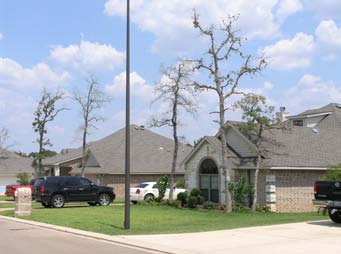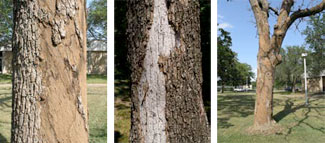Hypoxylon Fact Sheet 2
Download PDF
PLPA-115
Understanding, Recognizing, and Keeping Hypoxylon Canker of Oaks at Bay
| Part 2. Symptoms and Signs
Symptoms. As was described in Part 1 of this series (Cause and Biology), Hypoxylon Canker occurs in trees when they are stressed by environmental extremes. Trees in danger of succumbing to Hypoxylon canker therefore manifest all of the many symptoms typical of a declining tree (Figure 1). These symptoms include:
- Yellow, brown leaves,
- Small leaves and reduced twig growth,
- Thinning canopy,
- Dead limbs and branches,
- Epicormic shoots (water sprouts) growing ontrunks and large limbs,
- Dieback of feeder roots,
- Sapwood in the cankered area becomes white and stringy.
 Fig. 1. Declining trees at high risk to Hypoxylon canker. Fig. 1. Declining trees at high risk to Hypoxylon canker.
Signs. As these symptoms in the tree progress, the outer bark falls from the tree to expose the causal fungus, called Biscogniauxia (Hypoxylon) atropunctatum. The signs of the fungus are: |
- (early stages) light to dark reddish brown to olive green colored crusty fungal (stroma) tissue over the cankered area (Figure 2),
- (later stages) grey surface that eventually flakes off after 6 – 12 months to reveal a dark brown to black crusty material that gives a burnt appearance to the tree (Figure 2),
- (advanced stages) the signs of the fungus may first appear as small patches a few inches in length, but will eventually merge to form large strips along the trunk and major limbs of the tree (Figure 2).

Fig 2. Stages of Hypoxylon canker.
Once Hypoxylon canker is evident, it is usually too late to try to save the tree. Large portions of the tree will be dead, reducing the desirability as a landscape specimen. In addition, the structural integrity of the wood is compromised and the tree becomes hazardous. Trees exhibiting signs and symptoms of Hypoxylon canker should be carefully inspected and considered for removal.
Control of Hypoxylon Canker depends on maintaining vigorous healthy trees by reducing stress and is discussed in Part 3 of this series. |
Prepared by Sheila McBride1 and David Appel2
Diagnostician, Texas Plant Disease Diagnostic Laboratory1 and Professor, Plant Pathology and Microbiology2
Texas AgriLife Extension Service; The Texas A&M University System
May 22, 2009
The information given herein is for educational purposes only. References to commercial products or trade names are made with the understanding that no discrimination is intended and no endorsement by Texas AgriLife Extension Service personnel is implied.
Educational programs of the Texas AgriLife Extension Service are open to all people without regard to race, color, sex, disability, religion, age, or national origin.
The Texas A&M University System, U.S. Department of Agriculture, and the County Commissioners Courts of Texas Cooperating

